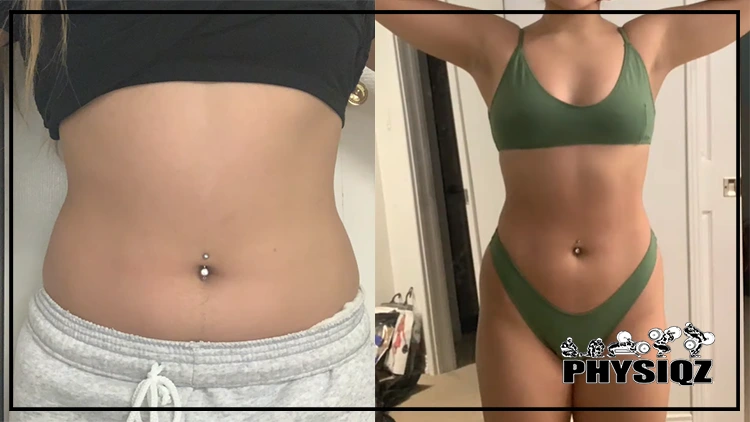
When seeking weight lifting results after 1 month, female lifters may find a great deal of inspiration and motivation in before and after photos of other women and their personal stories of achievement.1
Though everyone will have a unique fitness journey, many lessons and a lot of value can be taken from seeing what other women have accomplished. Before and after photos may be especially motivating for beginners who are just starting a strength routine.
How Long To Notice Results From Weight Training Female
For those who are curious about how long to see results from weight training, female lifters tend to begin seeing results within just a few weeks, but this can vary drastically depending upon many factors.
In only a week, toning results may begin showing but can be misleading as this can often be attributed, at least in part, to inflammation, glycogen, and fluid retention depending on food and water intake and nutrition.
Anyone concerned by their weight moving up on the scale after starting a strength routine may be comforted in learning that the inflammation and fluid retention can also contribute to this and water weight may cause them to weigh in heavier than expected in the short term.
Patience and consistency are vital in strength training for women, and within 2-4 weeks, weight loss and muscle toning are usually visible by eye as long as a caloric deficit is achieved.2 PHUL hypertrophy training and other similar training programs may help reach weightlifting results after 1 month, female and male alike.
All in all, women can expect to gain 1-2 pounds of muscle in a month but they must be in a caloric surplus. Inversely, and for women looking to lose weight and tone at the same time, a safe rate of weight loss is 1% of your current body weight which is typically 1-2 pounds per month too.
Though we’ll touch on weight lifting benefits for men and women later, let’s delve into the ins and outs of weight training for women.3
A Timeline of Benefits & Physique Changes From Weight Lifting
Perceptions of females in strength training may leave women with less exposure to and knowledge of strength training methods, benefits, safety precautions, and techniques; some may even be concerned about getting bulky but this is hardly the case unless it’s made a goal.4
Though generally less informed about weight lifting, women can gain valuable health benefits and confidence from lifting and building strength.
While everyone can build muscle and gain strength through dynamic and consistent weight lifting routines, someone of a median weight is likely to see the effects of firming, toning, and slimming down potentially sooner than someone who is overweight to begin with.
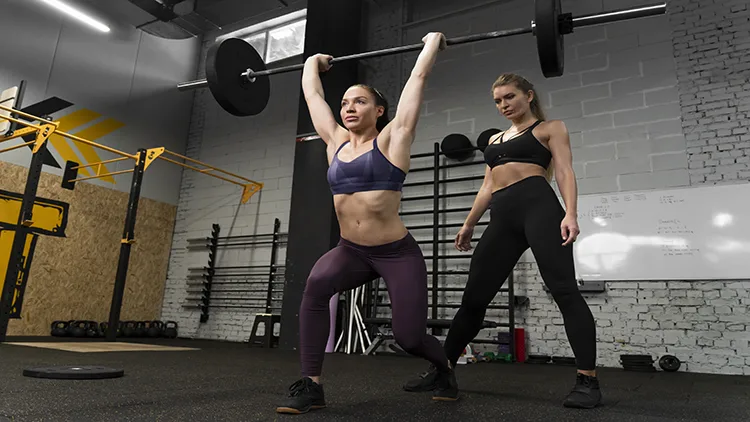
Image by Freepik5
For someone heavier who begins a similar strength program, muscle definition may come later as there is more fat to burn in certain areas (depending on body type and composition), so those starting overweight may want to have realistic expectations such as 1-2 lbs of weight loss per week, or approximately 1% of their body weight lost weekly.
Though it is often difficult and exhausting to stick to a workout program and maintain a schedule or routine, changes and benefits to one’s body already start on the very first day and can be easily lost if one falls off of their routine or skips many days in a row.
On the other hand, anyone who maintains their commitment and consistency will see and feel results from the first day through the first year and beyond.
The First Day of Weight Lifting: With the body doing something completely new and out of the ordinary, it is common to feel endorphins immediately after working out and before feeling tired, sluggish, and even fatigued easily and quickly on day one.
During long periods of rest, the body learns to conserve energy–so when it suddenly is exerting itself rigorously again, it must work especially hard to get blood flow to the heart and lungs to try to keep up.
The muscle fibers and blood vessels that have become somewhat atrophic are suddenly oxygenated and thus begin the process of being renewed and expanded. This can feel physically exhausting, just as one may also feel mentally drained due to the focus on new and unfamiliar movements.
The Day After Your First Workout: Many people are all too familiar with the agonizing soreness that comes after an intense workout–especially if they haven’t had one in some time.
This soreness and tenderness comes from the muscles rebuilding themselves and taking on minor tears and damage through the workouts.
A key signifier that one has done too much too soon is severe or excruciating pain the day following a new workout routine; slow and steady is best and it’s highly recommended to ease into any and all new programs or exercises. Or in other words, sometimes it’s best to ½ a workout routine if it’s your first time weightlifting.
Instead of resting, one should continue using these muscles and maintaining movement without overexerting, which will help loosen the muscles as they continue to both heal and work.
A lower appetite level and better sleep may also accompany the soreness, as your body adjusts to this new routine.
Two Weeks to One Month After Weight Lifting: While soreness should be subsiding or gone by this point, those who have stuck with a consistent routine should, by this point, feel higher levels of energy throughout the day and feel capable of pushing themselves further or harder.
Exercise is great for elevating one’s mood after the first week or so have passed, as endorphins soar. The body can literally produce greater amounts of energy to keep one feeling great and highly motivated to continue exercising.
The mental aspect is also very positive, as mental health and clarity thrive when the body is fueled and being taken care of.
By now, those who have made it this far will likely notice greater strength and ability to complete more repetitions or sets, even performing at a faster level or with greater weight lifted. This is in large part due to the cardiovascular system running more optimally and being trained to do its job well.
Visible changes may also slowly become noticeable in the mirror.
In 1 month workout results before and after pictures (weightlifting results after 1 month female), new lifters can often already show slight differences in body composition and physique, despite only putting a month of hard work in so far.
Although these may be very small differences, it’s entirely possible to achieve within a month and those who keep pushing will reap even greater rewards.
Three Months After Working Out: For weight lifting results 3 months, female weight lifters can expect to see much more clear and noticeable differences in their body shape, size, and composition.
By this point, others may also start seeing how much the hard work and dedication have paid off and friends and family members may comment on the new, more toned and defined look.
Additionally, those who have maintained their workout program to this point should feel that exercising and weight lifting have become a habit or routine, making it a little easier to stick with.
One Year After Weight Lifting: Everything from speed, frequency, reps, endurance, and strength are likely vastly and almost unrecognizably increased from day one. Flexibility, balance, and agility are probably all improved and one is likely to notice the benefits both in and out of the gym.
Someone who has remained consistent for a whole year probably has a much different amount of body fat and muscle mass than when they began; whether striving for weight loss or not, this can be a result of weight lifting and muscle tone increases while body fat composition drops.
With healthier organs, a clearer mind, and likely much lower levels of inflammation, aches, and pains, one who maintains a strength routine for a year should feel proud, accomplished, and much stronger.
1 Month Female Weight Lifting: Before & After Pictures Results
To celebrate weight lifting results after 1 month, female weight lifters may choose to take before and after photos to help measure their progress and physical transformation. Though every woman is likely to have her ups and downs, with patience, resilience, and unending persistence, anyone can succeed.
Upon starting workout routines at the gym, before and after 1 month, female lifters often choose to share their gains to inspire others; three of their stories follow.
Daisy’s Weight Loss Pictures & Story From Weight Lifting Results After 1 Month (Female)
Daisy, age 25, had yo-yoed between weight loss fad diets and various workout routines for years before finally deciding to give weight lifting a try and sticking with a routine.

From yo-yo dieting to sustainable fat loss and muscle gain, see the incredible transformation and inspiring story of how weight lifting became her go-to workout routine. Source: ✿ DAISYB ✿ on Youtube6
Her goal was to burn fat while building muscle simultaneously and weight lifting proved to be the perfect way to do so.
Melissa’s Weight Loss From Weightlifting Results After 1 Month (Female)
For the next weight lifting results after 1 month, female Melissa is a role model to women over 40 who want to get in the best shape of their lives but aren’t sure where to begin.

How weight lifting transformed her body and life in just one month, inspiring women over 40 to prioritize strength training for sustainable and healthy weight loss. Source: Melissa Neill on Youtube7
After many rounds of trial and error, Melissa, now 54, learned through experience that weight lifting was her key to weight loss without muscle loss and even became a bodybuilding competitor as well as a coach to other middle-aged women striving to get their bodies in better condition.
Tatyana’s Transformation Weight Loss & Weightlifting Results After 1 Month (Female)
Tatyana is 22-year-old and speaks openly about her coming to terms with her body shape, years of trying and giving up on various weight loss and fitness routines, and her long standing struggle with binge eating.
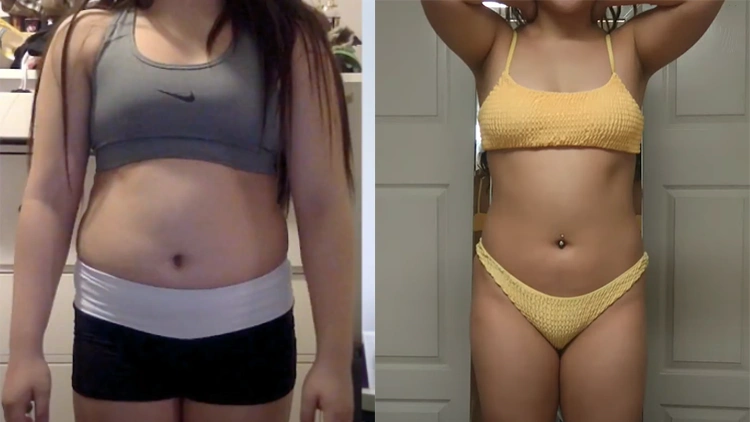
See how she overcame binge eating and found success with targeted workouts, fat burners, and supplements to achieve incredible results in just one month. Source: Tatyana Lopez on Youtube1
She is also transparent about using fat burners and supplements to aid in her weight loss, so take note that she did not achieve her results completely naturally. That being said, in her workouts, Tatyana targeted her glutes and abdomen, incorporating cardio about twice per week and including High Intensity Interval Training (HIIT) plans to increase muscle power.8
A Summary of Weightlifting Results After 1 Month: Female Gym Goers
Throughout the first month of maintaining a weight lifting program and refusing to give up, each of these ladies showed considerable progress in moving towards their fitness goals and overall health. Their age ranges provide a great example of why women of all ages should perform strength training.9
Daisy’s Results: With minimal cardio, Daisy focused on workouts for body recomposition, honing in on full body compound movements in her weight training. Within about a month, she had lost 12 lbs with a combination of exercises that worked her glutes and incorporated full body routines as well.
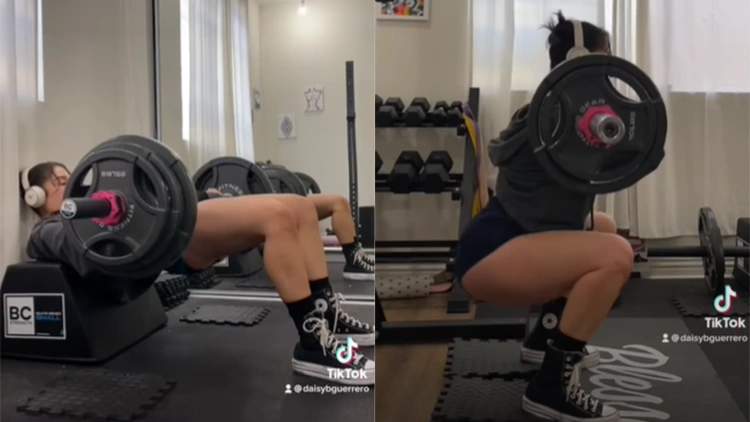
Daisy’s weight training routine. Source: ✿ DAISYB ✿ on Youtube6
Melissa’s Results: Melissa said that what finally clicked for her was refraining from focusing heavily on cardio, and instead going all in on strength training, high-protein meals, and intermittent fasting. Within 4-6 weeks, she had lost at least 10 lbs following her own self-made guidelines.
Tatyana’s Results: Tatyana mentioned that one of her primary motivations for really buckling down and sticking with it was hitting her heaviest weight and feeling tired, sluggish, and often experiencing pain.
With consistency for one month, she was able to show a considerable difference in her overall physique; however, she did not include the exact amount of weight she’d lost, citing her troubles with binge eating and the scale as the reason why she focused more on changes in strength and body composition.
4 Month Weight Lifting Transformation Female
For a 4 month weight lifting transformation, female athletes can look to various social media fitness influencers for inspiration and motivation, as examples abound. Thankfully these three featured women all continued documenting their strength routines and have follow-up photos and information that can serve as motivation for anyone seeking to follow in their footsteps.
Daisy’s 4 Month Update:
Although Daisy’s follow up timeline didn’t include any photos from the 4 month milestone, she did update at the 6 month mark and the photos shown below span from month 1 to month 6 on a consistent and rigorous weight lifting regimen.
For Daisy, variations in her nutrition proved to be a hindrance to her progress and she grew frustrated and temporarily stuck until sticking to a strict caloric deficit and consuming proper nutrients throughout the day. The combination of the caloric deficit and routine weight lifting helped her achieve both fat loss and muscle toning, with 24 lbs lost in about 6 months.

Daisy’s consistent weight lifting regimen and strict caloric deficit helped her achieve both fat loss and muscle toning, resulting in a total of 24 lbs lost. Source: ✿ DAISYB ✿ on Youtube6
Melissa’s 4 Month Update:
Similarly to Daisy, Melissa’s updated photo also came closer to 6 months than to 4, but her story is truly inspiring nonetheless. Melissa attributes her main “switch” that went off to being a mindset shift, which motivated her to work harder and stick with strength training to reach her goals and her dream body.
With a weak mind, she believes the body can never reach peak performance, so she works just as hard on having a healthy and positive mindset as she does on honing her muscles.
Throughout the initial 6 months of striving to better herself holistically, Melissa lost approximately 20 lbs but continued on her journey of pushing her body to its limits, sharpening her mind, and helping countless other women do the same along the way.

Melissa’s journey to a stronger body and mind is a true inspiration, her dedication to strength training and mindset shifts helped her lose approximately 20 lbs in the initial 6 months, but her journey of self-improvement continues as she pushes herself to new limits. Source: Melissa Neill on Youtube7
Tatyana’s 4 Month Update:
At the 4 month mark, Tatyana had drastically toned muscles all throughout her body and said she had a much healthier relationship to food as well. While she openly speaks about her fluctuations with her weight and her body image issues, Tatyana is an inspiration to women seeking a healthier body and mindset.
She says she is now in recovery from her eating disorder and emphasizes the importance of making the gym a habit and how great it feels to be a strong woman.
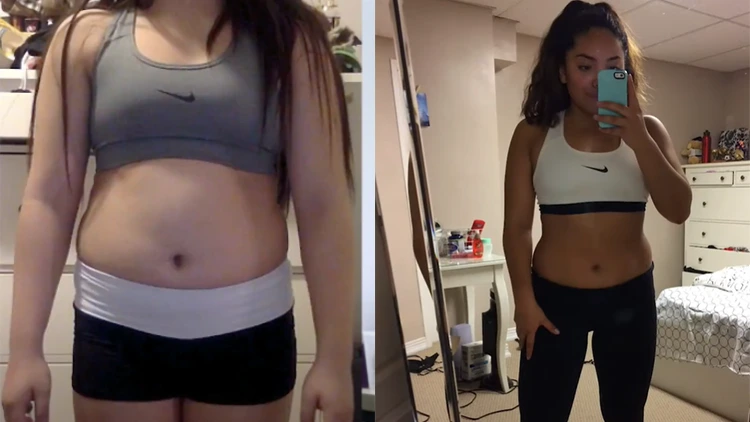
Tatyana has made incredible progress in just 4 months of weight lifting and healthy eating. Source: Tatyana Lopez on Youtube1
Factors That Will Determine the Rate of Weight Lifting Results & Progress
Before and after weight lifting, women took photographs to track their physical results and progress and we can see that even within the same time frame, each body changes in different ways or at various rates. This is due to the wide array of factors that can contribute to the rate of weight lifting results.
Countless variables influence weight lifting results and what they can look like from person to person and from one month to the next. This explains why some lifters feel they are getting stronger but not bigger; such variables include:
Genetics
Genetics play a larger role in weight lifting than one may assume. In fact, everything from the amount and types of muscle fibers to variations in total lean mass can be chalked up to genetic differences from person to person.
Genetics are so applicable to weight lifting results that they may be equally as informative and influential as the type and frequency of strength training itself.
Diet
While dietary habits play a major role in a person’s overall health and wellness, a diet can also greatly contribute or be detrimental to a weight lifting regimen; protein and carbs are great for snacks and meals around intense workouts and can fuel muscles for sustained energy.
Those on diet restrictions such as keto can certainly still lift weights, but should keep in mind the different nutrients their bodies may need for strength and endurance.
In contrast, foods and drinks high in sugar content, fried foods, and alcohol should all be avoided or at least drastically cut back on by anyone on a strength program.
Intensity
As can likely be inferred, intensity (weight or magnitude) plays a huge role in weight lifting progress, as those who lift a higher amount of weight with regularity will grow muscle at a greater rate than their counterparts who lift less, even if with the same frequency (such as moderate versus high intensity lifts).
Volume
In weight training, volume refers to the amount of reps completed in a set, such as 15 reps during squats. Those who continuously build up a higher volume over time will tend to see quicker results than those who decrease or maintain the number of reps lifted.
Of course anyone building up to a greater number of repetitions for higher volume should do so slowly and never jump drastically, so as to avoid injury or strain.
Form/Technique
Various forms and techniques when weight lifting can lead to different muscles targeted and therefore varying gains in strength in specific areas. For example, those who hold the bar with a narrow grip while doing a bench press will feel the burn in different muscles than someone using a wide grip.
Frequency
One common mistake for those just starting out on strength training programs or exercises is to set a resolution or goal and dive in head first on day one, then immediately regret it on day two. Slow and steady wins the race, as more muscle damage and soreness is caused with high frequency or intensity off the bat instead of scaling up over time.
Therefore, beginners should start out going to the gym (or doing home strength routines) no more than 3 times per week, with just a few sets of reps per exercise.
Current Weight
As one’s current body weight will play a huge role in how results look from person to person, when weight lifting for weight loss, female before and after photos and measurements can be extremely useful.
Weight lifting is a very individualized type of strength training and should be viewed as such. Each person should measure their progress against their past self, rather than their peers.
That’s why before and after photos can be so motivational, as one can see their progress without feeling despair comparing themselves to an experienced body builder of their same age. Comparison steals one’s sense of accomplishment, so each person should keep their eyes on their personal milestones.
Exercise Selection (Compound Lifts for Beginners)
Compound lifts that utilize muscles throughout large areas of the body and require multiple muscle groups will serve beginners well. As someone gets more comfortable, confident, and familiar with basic workouts and routines, periodized resistance training for strength and hypertrophy is something that intermediate and advanced weight lifters can benefit from.10
Those just starting out could also follow this beginner guide to workout routines.
Amount & Quality of Sleep
Any lifters hoping or striving to achieve body recomposition, increase muscle mass, or simply have proper energy for a grueling workout will need to ensure they’re getting plenty of restful sleep.
Muscle recovery primarily happens while at rest, specifically while one sleeps, so without keeping to a healthy sleep schedule, one could be more prone to muscle strain, injury, or simple yet dangerous mistakes with heavy equipment that stem from not thinking clearly.
Minimizing Stress
While always easier said than done, ridding oneself of stress or at least minimizing it can play a vital role in achieving desired muscle gain and results. Not only do the body and brain run at lower capacity when the mind is distracted, but higher levels of physical, mental, and emotional energy are focused towards the stress rather than the lifting.
Walking, journaling, meditating, and getting proper sleep can all help lower stress levels.
Benefits of Weight Lifting for Women & Men Alike
While many benefits of weight lifting have been listed above, many or all reasons why women should do weight training carry over and are applicable to men as well.11
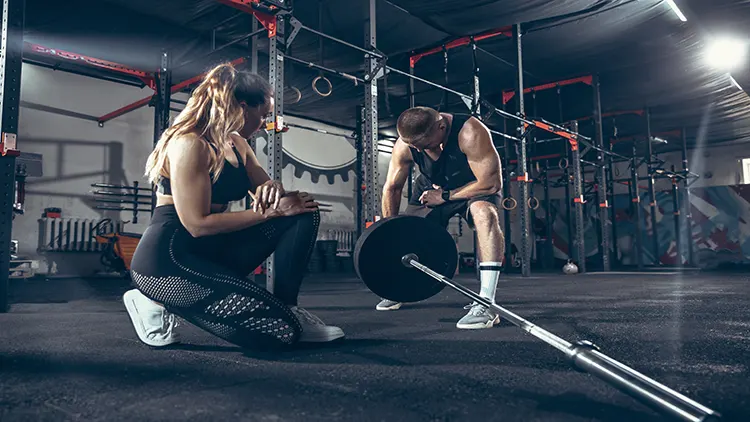
Image by master1305 on Freepik12
Both men and women on a powerlifting hypertrophy routine or any other powerlifting and power building routines and programs can reap the innumerable benefits of lifting, such as:
- boosting mental health
- skyrocketing one’s confidence
- elevating mood
- increasing metabolism
- toning and growing muscle
- losing body fat and contributing to weight loss
- maximizing strength
- increasing endurance
- heightening overall quality of life
How To Maximize Your Weight Lifting Results With Just 3 Steps
Though weight lifting results can be achieved through consistency, frequent reps, and increasing volume, there are a few more tips that can really maximize one’s performance.
These will take someone from good to great and achieve better results in less time.
Step 1: Eat Healthy and/or Try Dieting
Anyone frustrated and wondering why you’re only losing a pound per week while weight training might want to try incorporating healthier eating into their wellness plan. This can take many different forms, such as opting for just one healthier option each day, trying a certain diet or meal planning, or tracking caloric intake of their food and drinks.
If a person wants to increase muscle mass through their weight lifting, a surplus of calories is recommended; on the flip side, anyone hoping to lose weight through fat burning may benefit more from a caloric deficit. One can track food and count calories themselves or with many easy to use apps.
Even counting for a couple of weeks can give someone helpful insight into their true caloric intake and adjustments can be made up or down (or maintaining) from there.
Step 2: Optimize Factors Inside the Gym
Though weight lifting results can be achieved eventually through consistency alone, to maximize results, there are plenty of suggestions to help reach peak results sooner. Although lift-specific powerlifting routines can be utilized, simple compound movements work many muscles at once and tone across the board.
Those new to lifting should be patient and steady, never jumping ahead and lifting too much too soon or going overboard with reps–this is a recipe for disaster and injury and can set someone back much more in the long run. Remember to be consistent and stick with it, even if feeling stuck.
Powerlifting programs for beginners can be a great start, but anyone following such a program should start out with lighter weight and practice perfecting their form for a long time before eventually moving on to intermediate and perhaps later advanced powerlifting programs. At any level, be sure to deload every 4-8 weeks to give the muscles a brief break and to allow for recovery.
Dial In Sleep, Rest, Recovery & Persistence
Rest and recovery are absolutely key to any and all strength or fitness programs and should be adhered to just as much as proper form. Without allowing one’s body to fully recover and take breaks, a person is exponentially more prone to injury.
Muscles heal best during rest–especially sleep. In fact, sleep deprivation reduces muscle recovery, so don’t skimp on proper rest.13
For those who have a hard time with this, habit stacking may be a useful strategy. For example, if you can’t go without coffee in the morning, set a habit of going to the gym after the first cup of coffee.
It’s essentially where you put a habit you want to get better at right after one that you already have established. The same can be done for making your bed in the morning immediately after you brush your teeth.
Lastly, the importance of persistence cannot be stressed enough. Even on days where one feels a lack of motivation or is extra tired, just getting to the gym or doing a home workout and completing the bare minimum can be the difference between forming a habit and falling off completely.
Stick with it and the results will come.
For any female, weight lifting before and pictures are suggested as a useful tool to measure weight lifting progress and transformations.
Though one might not have reached their desired weight lifting results after 1 month, female weight lifters can usually see and feel results already by this time; anyone wanting to begin should start today and track progress as they go.
Frequently Asked Questions
What’s the Best Way To Track Weight Lifting Results Over Time?
While there are almost endless options for tracking weight lifting progress and results, one’s body weight, body measurements, before and after (and during) photos, measures of strength, and a DEXA scan can all be extremely useful and informative. Don’t get too hung up on the number on the scale, as this is not always a good signifier.
Should I Do Cardio Instead of, or on Top of Weight Lifting?
Cardio can certainly be paired with weight lifting, but should not replace strength routines. Working cardio in a couple of times per week on top of a solid weight lifting routine may provide the best results.
References
1Tatyana Lopez. “weightlifting + cardio for fat loss: how i started seeing results for my body type.” YouTube, 29 November 2021, Accessed 1 April 2023. <https://www.youtube.com/watch?v=AmuPxFqwfSs>
2Ebben, W. P., & Jensen, R. L. (1998, May). Strength training for women: debunking myths that block opportunity. National Institute of Health. Retrieved January 17, 2023, from <https://pubmed.ncbi.nlm.nih.gov/20086816/>
3Pierce-Smith, D., Turley, R., & Joseph, T. (2023). Weight Training for Women. University of Rochester Medical Center. Retrieved January 17, 2023, from <https://www.urmc.rochester.edu/encyclopedia/content.aspx?contenttypeid=1&contentid=2872>
4Kanel, V., & Rellinger, A. (2019). Females, Perceptions, and Strength Training. University of Akron. Retrieved 17 January, 2023, from <https://ideaexchange.uakron.edu/cgi/viewcontent.cgi?article=2282&context=honors_research_projects>
5Free Photo | Women training together full shot.” Freepik. Accessed 16 April 2023. <https://www.freepik.com/free-photo/women-training-together-full-shot_22896945.htm#query=halterofilia&position=23&from_view=keyword&track=sph>
6✿ DAISYB ✿. “2 year transformation. weight loss + muscle gain. what I did / tips & q&a.” YouTube, 29 November 2021, accessed April 2023. <https://www.youtube.com/watch?v=WTWkLFLMB-E>
7Neill, Melissa. “How to transform your menopausal body – fat loss over 40.” YouTube, 28 August 2022, Accessed 1 April 2023. <https://www.youtube.com/watch?v=vjeUJICwaik>
8Penillos, F., Camara-Perez, J., Soto-Hermoso, V., & Latorre-Roman, P. (2017, January). A High Intensity Interval Training (HIIT)-Based Running Plan Improves Athletic Performance by Improving Muscle Power. National Institute of Health. Retrieved January 18, 2023, from <https://pubmed.ncbi.nlm.nih.gov/27172268/>
9Casey, E., & Ribaudo, A. (2019, December 22). Why Women Should Perform Strength Training At Any Age. Hospital for Special Surgery. Retrieved January 17, 2023, from <https://www.hss.edu/playbook/why-women-should-perform-strength-training-at-any-age/>
10Evans, J. W. (2019, January 23). Periodized Resistance Training for Enhancing Skeletal Muscle Hypertrophy and Strength: A Mini-Review. National Institute of Health. Retrieved January 17, 2023, from <https://www.ncbi.nlm.nih.gov/pmc/articles/PMC6351492/>
11Queensland Health. (2018, March 28). 5 reasons why women should do weight training. Queensland Government Health. Retrieved January 17, 2023, from <https://www.health.qld.gov.au/news-events/news/why-women-should-do-weight-training>
12“Free Photo | Athletic man and woman with dumbbells.” Freepik. Accessed 16 April 2023. <https://www.freepik.com/free-photo/athletic-man-woman-with-dumbbells_9264174.htm#query=sport%20training&position=41&from_view=keyword&track=ais>
13Yang, D.-F., Shen, Y.-L., Wu, C., Huang, Y.-S., Lee, P.-Y., Er, N., Huang, W.-C., & Tung, Y.-T. (2019, October 15). Sleep deprivation reduces the recovery of muscle injury induced by high-intensity exercise in a mouse model. National Institute of Health. Retrieved January 18, 2023, from <https://pubmed.ncbi.nlm.nih.gov/31493480/>